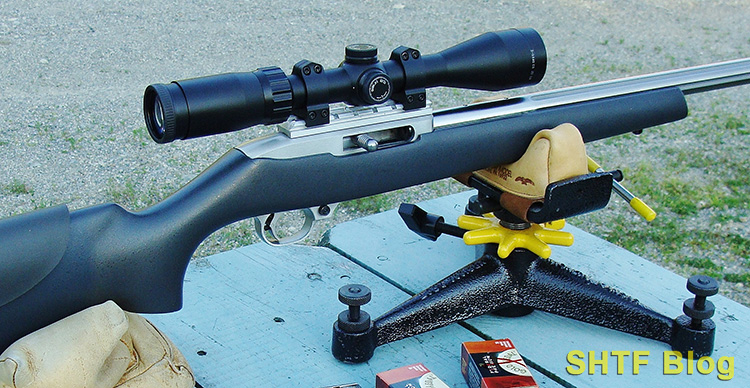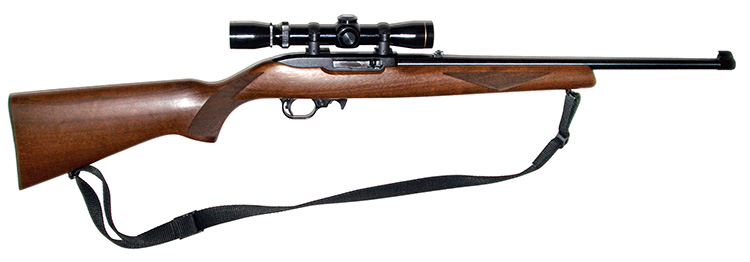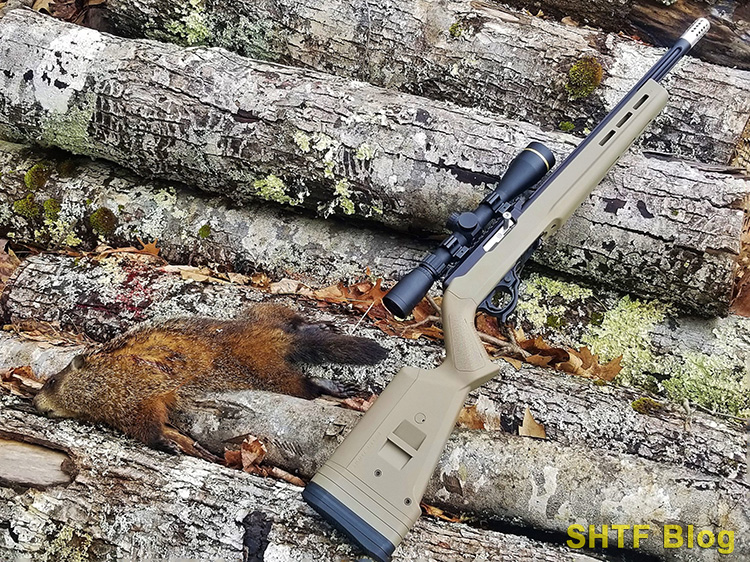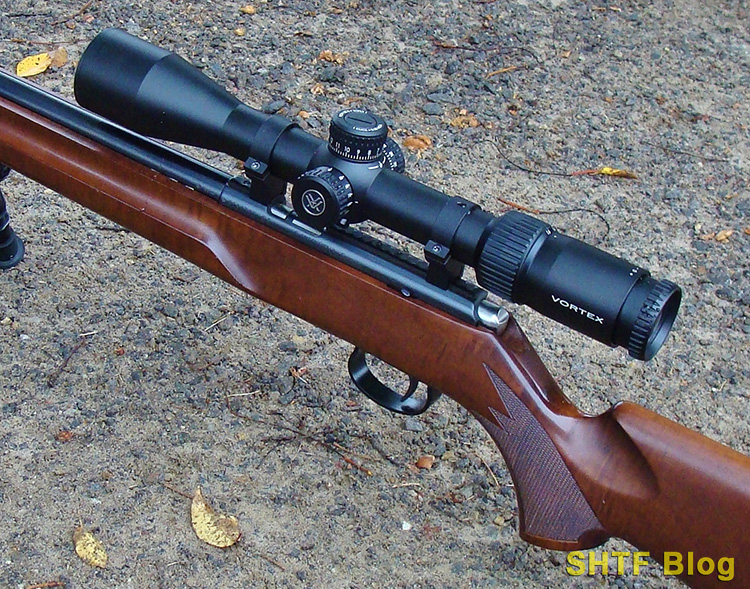With more than seven million rifles in circulation, Ruger’s 10/22 has earned top billing as America’s favorite rimfire rifle. Amazingly, the popularity of this .22 LR semiautomatic remains undiminished despite five-plus decades of sales. Many are standard carbines, others are high-end tack-drivers, and some are even copies from competing manufacturers.
Standard 10/22s are usually factory-equipped with iron sights, but like heavier-barreled target models, they’ll often benefit from the addition of a scope. Which begs a couple questions; what are the best Ruger 10/22 scopes, and how much will they cost?

Why Spend More?
The blister-pack offering of scopes sold in big box stores are tempting deals, but as many consumers have discovered, there’s more to a scope than its price. Fortunately, a number of basic but useful rimfire options can be found that won’t break the bank. For a bit more cost, additional features are available – assuming they’re actually necessary.
Price Checks
Some centerfire rifle competitors won’t bat an eye at a scope costing well above two grand. Precise internals and exceptional glass account for much of the expense, which hasn’t slowed demand in the least. The driving force is recent wave of long-range precision rifle events, with some shots at a thousand yards or farther.
When targets approach these distances, trajectory and wind become major concerns. Most participants use their turrets to compensate for drop, and some also dial windage. However, because minor mechanical inconsistencies can result in missed targets, precise construction is essential.
Precision-rimfire competitors face similar challenges at 300 yards – one heck of a poke for a .22 LR! Some use the same scopes as centerfire shooters. Others do okay with scopes priced below a thousand dollars (like the 30mm Vortex that made the list). Those from either category are often mounted to high-end 10/22s, but most are too large and costly to qualify as general-purpose scopes.

At the opposite end of the spectrum, the market is full of inexpensive scopes, most of which come from China. And, if they retail for less than $100, corners have been cut. Expect anti-reflective coatings to be minimal or non-existent. Internal lenses could be plastic, along with some parts of the turrets.
If so, adjustments will be inconsistent and probably short-lived. Some shooters luck out with easy zeros, cap the turrets, and never touch ‘em again – not a bad idea for the next tier of scopes hovering a bit above the Benji-mark. Or, move up another notch…
A Practical Compromise?
Minor mechanical errors add up at extreme distances, but most .22 LR bullets are sent down range inside 50 yards. Targets are often those of opportunity, from small game to beverage cans. And, if the rifle is a basic 10/22, it’ll probably be firing whatever bulk-pack .22 LR ammo is available.
Still, 50-yard groups of around an inch should be possible; not match-grade but certainly useful. You can save some coin through mid-grade optics; those that offer good, if not perfect performance.
Part of the expense relates to durability. Given enough time, the cumulative effect of a reciprocating steel bolt can unravel a cheesy scope. Another reason to spend a bit more involves possible upgrades to your modification-friendly 10/22.
Custom Compatibility
Whether intended or not, many 10/22s that start out as plain-Janes eventually morph into customized versions – something worth considering if shopping for a scope. The brilliance of Ruger’s 10/22 design is its modularity.
Just about anyone with a basic grasp of hand tools can create their own custom .22 rifle on a kitchen table thanks to an abundance of aftermarket trigger assemblies, stocks, barrels, and other widgets. (Actually, a complete 10/22 clone can be assembled without any Ruger parts).
Some of the scopes shown will cover these transitions. They’re not too small, but not too large.
Sizes Matters
Not all that many years ago inexpensive (as in cheap), skinny 7/8-inch scopes were the choice for .22 rifles. Fortunately, today’s rimfire scopes tend to mirror their centerfire counterparts. Those with one-inch tubes are the most common, and many are nice matches for 10/22 sporters.
Scopes with 30mm tubes are almost as popular. The larger diameter can better accommodate the circuitry required for illuminated reticles, and the reticles can incorporate additional aiming points. The fatter tube also provides room for increased turret travel. For us rimfire nuts, this means hits on 10-inch plates can be doable at 300 yards – with quality .22 LR ammunition.
To my mind though, a 30mm scope seems out of place on a sporter-size 10/22. Mount a small 1-inch scope to the same rifle and the result will be near-perfection. Leupold’s 4X and 2-7X Rimfire Scopes are listed for this reason. Although more spendy than some others, either is a one-time investment.
An accurate bull-barrel 10/22? That’s another matter. The 30mm Vortex listing seems right at home on one, and it’ll work at stupid-long distances.
How about the advertised numbers?
A 3-9X40 is a variable-power scope offering magnifications three to nine times larger than the actual target. The additional number represents the diameter of the scope’s front lens (objective) in millimeters. And, more isn’t always better. A higher number usually translates to a larger scope, some of which can create mounting hassles.
Rimfire Scopes: Key Features

Just about every scope incorporates an eyepiece (ocular) focus, needed to gain sharp crosshairs. Fast-focus (twist) versions are popular. Traditional designs require rotation of the ocular bell, set via a locking ring. I’m partial to the latter because the focus is less likely to change – but I’m the sole user.
Eye relief is worth considering (distance from eyeball to ocular lens that provides a full image). Although less critical with rimfires, three-inches is a more useful minimum. FYI, the distance may decrease as magnification is increased.
Magnification relates to field of view (FOV), the area visible through the scope. More power decreases FOV, meaning it can be harder to locate targets – especially at closer rimfire distances. This explains why intermediate-magnification scopes of 2-7 or 3-9X have long been popular in the deer woods. Similar magnifications are useful for many 10/22s – assuming they incorporate some key rimfire features.
Focal Planes and Reticles
Most variable-power U.S. scopes are second focal-plane designs, meaning the image will correspond with the magnification setting – while the reticle’s size won’t change. This can create confusion with so-called ballistic reticles. Although hold-over points can stretch the useful range of a rimfire, advertised 2nd FP values are valid only at the scope’s maximum magnification.
Lately, first focal plane scopes have become more popular. Why? Because a FFP reticle expands or contracts with the image. Thus, those with range-compensating features will work at any magnification. The Vortex (below) checks this box.
Rimfires and Parallax
Point-of-impact (POI) shifts can occur when a scope’s reticle isn’t on the same plane as the image. If that condition (parallax) exists, off-center alignment of the shooter’s eye with a scope’s center can result in larger shot groups. Most centerfire rifle scopes are set to be parallax-free at 100 to 150 yards.
It’s possible to use such a scope on a .22 LR, but head position will become increasingly critical as distances decrease. For this reason most rimfire scopes are factory set to be parallax-free at around 50 – 60 yards.
For a bit more cost, some models feature external adjustments capable of eliminating parallax at chosen distances. Some employ adjustable objective (front) lenses with graduated yardage scales (as close as 7 yards for airgun use). The side-focus models employ a dial on the turret housing.
The latter has caught on in a big way because it’s a prone-friendly design, but either type will do the job – assuming the scale actually correlates with the yardage.
Once more, you’ll usually get what you pay for. I’d skip a lower cost PA scope in favor of a pre-set rimfire version – still plenty useful for most 10/22 roles.
Affordable Ruger 10/22 Scopes
The sampling of a half-dozen Ruger 10/22 scopes that follow is a directly result of positive firsthand experiences. Most are middle of the road scopes, and none are high-end competition models – but not $45 specials, either. All of ‘em have MSRPs of less than $500, but some can be purchased for less.
Except for the 30mm Vortex, capped turrets and one-inch tubes are standard. Adjustments are ¼ moa (1/4” at 100 yards) again with one exception; the Burris turrets feature more precise 1/8 moa clicks. Field of view is listed in feet at 100 yards.
Expect few mounting headaches from any of these scopes. Still, it’s worth spending a few extra bucks for a durable set of mounts. Many good ring sets will attach to a factory-supplied Ruger base. Other options include quality aftermarket base and ring systems.
1 – Cabelas Intensity Rimfire Rifle Scope, 3-9×40

I bought this scope (or one close to it) via Cabela’s points and wound up mounting it to a tricked-out 10/22. The image was clear, bright, and easily brought into focus. POI did shift during magnification changes, but only by a small amount; less than ½ moa (1/4-inch at 50 yards).
Once zeroed at 50 yards with .22 LR high-speeds, the “ballistic drop compensating” reticle (BDC?) was on the money at 100 yards – as far as I tried it.
The country of origin is China. Will it last the long haul? I dunno, but if not, it can be returned for a store credit.
Note: The Rakuten coupon browser extension gives 3.5% cash back on Cabela’s purchases.
| Reticle | RF-BDC |
| Eye Relief | 4” |
| FOV | 34.7 – 11.5’ |
| Parallax | Free @ 50 yards |
| Length | 12.5” |
| Weight | 15 oz. |
| MSRP | $119.95 |
2 – Leupold FX-1 4X28mm Scope

This could be the perfect bug-out scope for a Ruger takedown 10/22 (which made my list of best bug out guns).
Tough as nails but extremely compact, the trouble-free fixed-4X seems especially well-suited for rough conditions. The optical quality and reticle are up to any normal rimfire chores. If zeroed with a high-speed JHPs at 50 yards, squirrels or other small critters will be in trouble.
Another plus: Leupold stands behind their products with outstanding warranty and customer service. Made in the USA, too!
| Reticle | Fine Duplex |
| Eye Relief | 4.5” |
| FOV | 25.5’ |
| Parallax | Set for 60 yards |
| Length | 9.2” |
| Weight | 7 oz. |
| MSRP | $299.99 |
3 – Leupold VX-Freedom Rimfire Riflescope 2-7x33mm

Same comments as above. This small variable is a nice match for just about any sporter-type 10/22, especially if size is a concern.
Unlike some other velocity-specific ballistic reticles, this one is graduated by minutes-of angle (moa). As such, it has the flexibility to work with all .22 LR loads – at any reasonable rimfire distances.
| Reticle | Rimfire MOA |
| Eye Relief | 4.2 – 3.7” |
| FOV | 43.8 – 29.8’ |
| Parallax | Set for 60 yards |
| Length | 11.4” |
| Weight | 11.1 oz. |
| MSRP | $299.99 |
4 – Leupold VX-Freedom 3-9×33 EFR

Nice all-around 10/22 choice suitable for future upgrades. This model is parallax adjustable, and its extreme focus range (EFR) setting will provide maximum accuracy at all rimfire (or airgun) distances.
| Reticle | Fine Duplex |
| Eye Relief | 3 – 3.4” |
| FOV | 37.2 – 14.1’ |
| Parallax | Adjustable via rotating objective bell, as close as 10 yards |
| Length | 11.43” |
| Weight | 12.1 oz. |
| MSRP | $399.99* |
5 – Vortex Diamondback Tactical 4-16×44 FFP (30mm tube)

This is a scope I’ve reviewed before. I planned on mounting this scope to an HB 10/22, but because I owned a set of 30mm Warne grooved receiver rings, it wound up on an Anschutz M-1416 .22 LR bolt-action. The first focal plane MOA reticle worked perfectly (Vortex also offers a mil-dot version), and the ¼ moa target turrets tracked as advertised.
I had no trouble hitting 10” steel plates at 300 yards in a light breeze through a combination of turret come-ups and reticle hold-points. Although received for testing purposes, I’m now the happy owner.
Made in China, it’s supported by the Vortex VIP Warranty.
| Reticle | MOA version, first focal plane |
| Eye Relief | 3.8” |
| FOV | 26.9 – 6.7’ |
| Parallax | Side focus, as close as 20 yards |
| Length | 14” |
| Weight | 23.1 oz. |
| MSRP | $449.99 |
Other Picks?
I’ll admit to ownership of one blister-pack rimfire scope, a basic 4X Bushnell rimfire version (of some sort). Ever since purchasing it at least ten years ago, this scope has been mounted to a 1960s single-shot .22 Remington Model 510 bolt-action.
The scope endures without issues in its chintzy 1” rings, possibly due to a diet of .22 Shorts. Other more expensive but still affordable Bushnell scopes may keep 10/22 owners happy. Their lenses are generally crystal clear, and FOV is typically forgiving:
If you’re fortunate enough to encounter a no-longer-produced Burris Rimfire/Airgun Mini Scope, you might want to snatch it up. I own Burris Minis in 4X, 6X, 3-9X, and 4-12X versions. All (except the tiny 4X) are PA models rated for snappy airguns and centerfires. Eye reliefs are generous, although full field-of-view becomes touchy with the 4-12X on its maximum setting (easily corrected at 10X).
No doubt other rimfire afficionados will have entirely different favorites for completely valid reasons. But, again, I went with hands-on experience. If you have experience with other reliable Ruger 10/22 scopes then by all means share in the comments section.
In closing, although rimfires don’t generate much recoil, good mounting systems are the ticket to reliable performance. That’s a topic for another post.
Meanwhile, happy shooting!
Want to learn a whole lot more about shooting rimfire rifles? See Steve’s book on the subject, Rimfire Rifles: A Buyer’s and Shooter’s Guide.
- Markwith, Steve (Author)
- English (Publication Language)
- 182 Pages - 09/28/2015 (Publication Date) - Prepper Press (Publisher)
